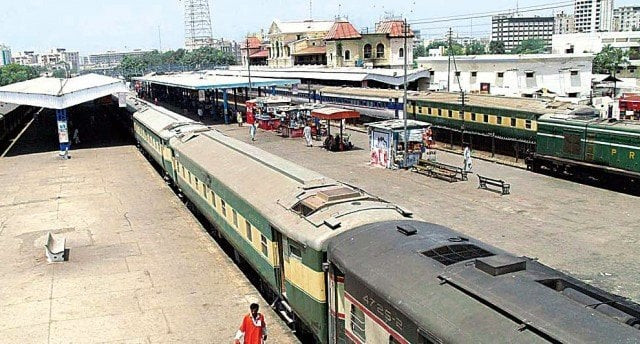ML-I financial close likely in FY22
Planning Minister Asad Umar hopeful of securing funding for $7b railway project

Planning Minister Asad Umar on Tuesday hoped to secure financing for the Mainline-I project of the China-Pakistan Economic Corridor (CPEC) in next fiscal year, saying that one of the irritants in reaching a deal was the Chinese banks’ reluctance to lend new loans.
The Chinese banks had financed CPEC energy projects but their money was stuck in the power circular debt, said Umar while addressing a press conference along with CPEC Authority Chairman Asim Saleem Bajwa.
The government has started clearing the circular debt and this would address their concern, said Umar.
About Rs209 billion were due to Chinese investors power plants and at least two coal-based CPEC power plants were facing financial issues in ensuring uninterrupted coal supplies, an official told The Express Tribune.
Pakistan wants to expand and modernise its dilapidated rail infrastructure through $7 billion Chinese investment. But the project is facing delays due to lack of financial close of the project.
The proposed Annual Plan 2021-22 for next fiscal year’s says that ML-I’s “financial close is expected in the year 2021-22”.
Read more: PR to switch 155 railway stations to solar power
However, the government has allocated only Rs6.2 billion for the ML-I project in this budget, which is 38% less than what it had indicated at the initial budget approval process stage.
Bajwa said that CPEC’s second phase was making progress and the government has made Rs87 billion allocation in the budget for CPEC projects.
The Pak-China Industrial cooperation agreement is the deliverable for the next Joint Cooperation Committee (JCC) meeting. But absence of the industrial agreement has not stopped work on the CPEC industrial zone, said Bajwa.
The chairman said that one Chinese investor has invested in Rashakai zone and four are investing in Faisalabad zone.
The CPEC Master Plan is integrated with Pakistan’s economic plan, said Bajwa.
Pakistan is keen to sign a framework agreement on industrial cooperation during the next JCC meeting. However, the Chinese authorities were not willing to enter into another framework agreement. Pakistan is trying to show progress on at least three SEZs – Rashakai SEZ in Khyber-Pakhtunkhwa, Allama Iqbal SEZ in Punjab and Dhabeji SEZ in Sindh. The development agreement for Rashakai SEZ had been concluded in September last year.
The government has allocated Rs7 billion in the budget for meeting power requirements for Rashakai, Allama Iqbal, Dhabeji and Bostan SEZs are estimated at 885 megawatts in addition to 110 mmcfd gas requirements, according to the proposed annual plan.
Bajwa said China was also cooperating with Pakistan in the agriculture sector and supporting in cotton seed development. Pakistan will share its agriculture plan with China and the Chinese investors are keen to invest in modern corporate farming, said the chairman.
Bajwa said that three dams will be made in Balochistan for agriculture purposes.
There has not been any meeting of Joint Working Group on agriculture since April last year. In the last meeting, the working group had agreed to formulate an action plan for agriculture with emphasis on enhancing productivity of major crops, value addition in agri produces, reducing post-harvest waste and pest and disease controls.
Bajwa said that there will be focus on the western route of CPEC and the government has made Rs42 billion allocation in the next budget.
On the western alignment, Hakla-Dera Ismail Khan section is under construction, said Bajwa. The chairman said that this road will be completed by November this year. The Zhob-DI Khan segment is included in the JCC and the work on Zhob to Quetta has already begun. Bajwa said that the construction of the Gwadar-Khuzdar section will also be completed by November this year.
Umar said that the government has proposed 31% of the next year’s budget for regional equalisation as a nation cannot be kept united with force of tanks and guns.
Umar said that Chinese financing for projects will reduce in coming years due to shifting of focus from public sector projects to private sector led projects.
The minister also spoke about objections raised by Sindh Chief Minister. The centre was spending billions of rupees on several projects in the province, he added. Against Rs93 billion allocations for Punjab projects, Sindh is being given Rs90 billion, said Umar.
CM Murad last week expressed his reservations over the upcoming budget, saying that ever since the PTI-led government had come to power, it had been “biased” towards the province.
Umar, while responding to CM Murad’s objections, said any province including Sindh cannot dictate the centre about the federal development budget. “It’s the prerogative of the federal government to spend money on projects of its own choice. However, we do take provinces’ input,” he said. “But they cannot dictate the federal government,” he stressed.
“The PPP government from 2008 to 2013 did not develop a single inch of motorway in the province,” said the planning minister.
The minister said that there was not sufficient space in the PSDP to finance mega infrastructure projects, therefore, the government has decided to collaborate with the private sector. An amount of Rs61 billion has been kept in the budget for viability gap funding of public private partnership projects, he added.
Umar admitted that the quality of the projects being added in the next PSDP was not good and it has been decided that no new project will be accepted for inclusion in the PSDP after March next year.
He said that against an allocation of Rs650 billion, the actual spending is estimated at 90% of the allocation. He hoped that in the next fiscal year about 320 projects will be completed.



















COMMENTS
Comments are moderated and generally will be posted if they are on-topic and not abusive.
For more information, please see our Comments FAQ